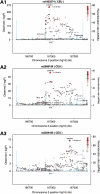GWAS of butyrylcholinesterase activity identifies four novel loci, independent effects within BCHE and secondary associations with metabolic risk factors
- PMID: 21862451
- PMCID: PMC3196893
- DOI: 10.1093/hmg/ddr375
GWAS of butyrylcholinesterase activity identifies four novel loci, independent effects within BCHE and secondary associations with metabolic risk factors
Abstract
Serum butyrylcholinesterase (BCHE) activity is associated with obesity, blood pressure and biomarkers of cardiovascular and diabetes risk. We have conducted a genome-wide association scan to discover genetic variants affecting BCHE activity, and to clarify whether the associations between BCHE activity and cardiometabolic risk factors are caused by variation in BCHE or whether BCHE variation is secondary to the metabolic abnormalities. We measured serum BCHE in adolescents and adults from three cohorts of Australian twin and family studies. The genotypes from ∼2.4 million single-nucleotide polymorphisms (SNPs) were available in 8791 participants with BCHE measurements. We detected significant associations with BCHE activity at three independent groups of SNPs at the BCHE locus (P = 5.8 × 10(-262), 7.8 × 10(-47), 2.9 × 10(-12)) and at four other loci: RNPEP (P = 9.4 × 10(-16)), RAPH1-ABI2 (P = 4.1 × 10(-18)), UGT1A1 (P = 4.0 × 10(-8)) and an intergenic region on chromosome 8 (P = 1.4 × 10(-8)). These loci affecting BCHE activity were not associated with metabolic risk factors. On the other hand, SNPs in genes previously associated with metabolic risk had effects on BCHE activity more often than can be explained by chance. In particular, SNPs within FTO and GCKR were associated with BCHE activity, but their effects were partly mediated by body mass index and triglycerides, respectively. We conclude that variation in BCHE activity is due to multiple variants across the spectrum from uncommon/large effect to common/small effect, and partly results from (rather than causes) metabolic abnormalities.
Figures





Similar articles
-
Acetylcholine-metabolizing butyrylcholinesterase (BCHE) copy number and single nucleotide polymorphisms and their role in attention-deficit/hyperactivity syndrome.J Psychiatr Res. 2013 Dec;47(12):1902-8. doi: 10.1016/j.jpsychires.2013.08.006. Epub 2013 Aug 30. J Psychiatr Res. 2013. PMID: 24041656
-
The Association of Type 2 Diabetes Loci Identified in Genome-Wide Association Studies with Metabolic Syndrome and Its Components in a Chinese Population with Type 2 Diabetes.PLoS One. 2015 Nov 24;10(11):e0143607. doi: 10.1371/journal.pone.0143607. eCollection 2015. PLoS One. 2015. PMID: 26599349 Free PMC article.
-
Genome-wide association study of morbid obesity in Han Chinese.BMC Genet. 2019 Dec 18;20(1):97. doi: 10.1186/s12863-019-0797-x. BMC Genet. 2019. PMID: 31852448 Free PMC article.
-
APOE and BCHE as modulators of cerebral amyloid deposition: a florbetapir PET genome-wide association study.Mol Psychiatry. 2014 Mar;19(3):351-7. doi: 10.1038/mp.2013.19. Epub 2013 Feb 19. Mol Psychiatry. 2014. PMID: 23419831 Free PMC article.
-
Butyrylcholinesterase Protein Ends in the Pathogenesis of Alzheimer's Disease-Could BCHE Genotyping Be Helpful in Alzheimer's Therapy?Biomolecules. 2019 Oct 9;9(10):592. doi: 10.3390/biom9100592. Biomolecules. 2019. PMID: 31601022 Free PMC article. Review.
Cited by
-
Genome-wide association study of 17 serum biochemical indicators in a chicken F2 resource population.BMC Genomics. 2023 Mar 2;24(1):98. doi: 10.1186/s12864-023-09206-7. BMC Genomics. 2023. PMID: 36864386 Free PMC article.
-
Occurrence of butyrylcholinesterase polymorphisms in patients undergoing surgery in Slovakia.Caspian J Intern Med. 2023 Summer;14(3):490-494. doi: 10.22088/cjim.14.3.490. Caspian J Intern Med. 2023. PMID: 37520883 Free PMC article.
-
Glucokinase regulatory protein: a balancing act between glucose and lipid metabolism in NAFLD.Front Endocrinol (Lausanne). 2023 Aug 29;14:1247611. doi: 10.3389/fendo.2023.1247611. eCollection 2023. Front Endocrinol (Lausanne). 2023. PMID: 37711901 Free PMC article. Review.
-
Butyrylcholinesterase Deficiency Promotes Adipose Tissue Growth and Hepatic Lipid Accumulation in Male Mice on High-Fat Diet.Endocrinology. 2016 Aug;157(8):3086-95. doi: 10.1210/en.2016-1166. Epub 2016 Jun 14. Endocrinology. 2016. PMID: 27300766 Free PMC article.
-
Genetic insights into cardiometabolic risk factors.Clin Biochem Rev. 2014 Feb;35(1):15-36. Clin Biochem Rev. 2014. PMID: 24659834 Free PMC article. Review.
References
-
- Evans F.T., Gray P.W., Lehmann H., Silk E. Sensitivity to succinylcholine in relation to serum cholinesterase. Lancet. 1952;1:1229–1230. - PubMed
-
- Jensen F.S., Skovgaard L.T., Viby-Mogensen J. Identification of human plasma cholinesterase variants in 6688 individuals using biochemical analysis. Acta Anaesthesiol. Scand. 1995;39:157–162. - PubMed
-
- Kutty K.M., Huang S.N., Kean K.T. Pseudocholinesterase in obesity: hypercaloric diet induced changes in experimental obese mice. Experientia. 1981;37:1141–1142. - PubMed
-
- Annapurna V., Senciall I., Davis A.J., Kutty K.M. Relationship between serum pseudocholinesterase and triglycerides in experimentally induced diabetes mellitus in rats. Diabetologia. 1991;34:320–324. - PubMed
-
- Abbott C.A., Mackness M.I., Kumar S., Olukoga A.O., Gordon C., Arrol S., Bhatnagar D., Boulton A.J., Durrington P.N. Relationship between serum butyrylcholinesterase activity, hypertriglyceridaemia and insulin sensitivity in diabetes mellitus. Clin. Sci. (Lond.) 1993;85:77–81. - PubMed
Publication types
MeSH terms
Substances
Grants and funding
- K05 AA017688/AA/NIAAA NIH HHS/United States
- AA13320/AA/NIAAA NIH HHS/United States
- P42 ES010337/ES/NIEHS NIH HHS/United States
- MH66206/MH/NIMH NIH HHS/United States
- AA17688/AA/NIAAA NIH HHS/United States
- AA11998/AA/NIAAA NIH HHS/United States
- R37-GM18360/GM/NIGMS NIH HHS/United States
- AA14041/AA/NIAAA NIH HHS/United States
- AA07535/AA/NIAAA NIH HHS/United States
- R37 GM018360/GM/NIGMS NIH HHS/United States
- AA13326/AA/NIAAA NIH HHS/United States
- DA12854/DA/NIDA NIH HHS/United States
- P42-ES010337/ES/NIEHS NIH HHS/United States
- AA13321/AA/NIAAA NIH HHS/United States
- AA10248/AA/NIAAA NIH HHS/United States
LinkOut - more resources
Full Text Sources
Miscellaneous

